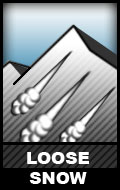Weekend Avalanche Outlook
Issued Saturday, March 18, 2017 at 2:00am:
*Generally safe avalanche conditions. Watch for unstable snow on isolated terrain features.*
Avalanche Problems:
Small, human triggered wind slabs are possible in isolated areas on steep (35*+), upper elevation (3000’+) terrain. Northerly winds have generally ravaged the mountain snow. Unstable wind slabs may exist sporadically in areas where the north wind has been stronger and/or more persistent. Be on the lookout for wind loaded and cross loaded pockets of punchier, deeper snow on leeward (primarily southerly) terrain near peaks and along ridges and gully sidewalls; these will be the most likely areas of unstable snow. Remember that while a wind slab may not be large enough to bury you, terrain traps (where the debris could pile up especially deep or you could take a traumatic fall) can seriously compound the consequences.
Human triggered persistent slabs up to D2.5 in size are possible in isolated areas on steep (35*+), upper elevation (3000’+) terrain on multiple aspects. These persistent slabs are a very low probability, but potentially high consequence hazard. Dangerous persistent slabs are most likely to be triggered on steep, high alpine terrain in areas where the human “stress bulb” may penetrate deeper into the snowpack and initiate fracture in the widespread basal weak layer, or perhaps (but less likely) on a lingering pocket of intact buried surface hoar. “Sweet spots” for triggering a persistent slab may include steep upper elevation slopes where there are sparsely protruding rocks (harboring facets closer to the surface) and thin areas of the snowpack where the hard slab and persistent weak layer combo exists, especially at steep rollovers (convexities) where the snowpack lacks compressive support. Lingering persistent slabs will behave very unpredictably, with hard slab characteristics, potentially releasing above and around a human trigger making escape difficult.
Fast moving and potentially high volume human triggered sluffing is possible where there is sheltered, soft snow on steep (35*+) terrain. This soft “recycled powder” is heavily faceted, very loose, and uncohesive. Don’t underestimate it’s potential to gather speed and volume. Practice effective sluff management, and keep the consequences of a fall or loss of control in mind.
There is also the potential for wet loose avalanches this weekend on steep solar aspects (primarily south to west), especially initiating from snow dropping from rocks that warm in the sun. Be conscious of the temperature and solar effect on the snow. Also, watch for rockfall associated with the sun warming snowy rock in channeled terrain.
North winds have transported a lot of snow in the past few weeks; cornices may be large and weak in some areas. As always, don’t approach a snowy ridge line to look down slope unless you’re sure it’s not corniced. Cornice falls are inherently dangerous, and they can also trigger an avalanche as they “bomb” the slope they fall onto. Give corniced ridges a wide berth; they have the potential to break further back than may be expected.
Mountain Weather:
Expect mostly sunny skies with generally light winds and alpine temperatures from lower 20s to upper single digits (decreasing with elevation gain).
__________
Many avalanche accidents that have happened in Anchorage’s backyard of Chugach State Park could have been prevented by basic avalanche awareness. If you don’t have this level of awareness, here are some online resources to help you start the learning process. There are also numerous options for getting a real avalanche education locally.
__________
*click avalanche problem icons and hyperlinks for further info



